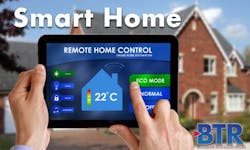Research firms provide operators and vendors valuable insight into consumer preference and trends, particularly when a technology trend is on the rise and holds so many possibilities, as does the concept of the smart home.
The number crunchers and analysts have been working furiously with regards to smart devices. Parks Associates recently reported, for example, that in the United States, 17% of households own both an Internet-connected entertainment device and a smart home device, while 13% of consumers own both a connected health device and a smart home device.
Parks also said that more than 50% of U.S. broadband households have a smart TV, and more than 40% own a streaming media player. Voice control allows consumers to control cameras, sensors and streaming through the same interface. They want simplicity, and that desire controls their choice of platform, Parks said.
Another Parks' study indicated that nearly 75% of consumers who are planning to buy a smart home device consider it important that their purchase be able to work with other products in the home. The demand for interoperability is stronger than brand loyalty. Less than 60% of smart home shoppers surveyed said they consider it important that their future purchases be the same brand as their current products.
Parks said Amazon Echo, Google Home, and Works with the Nest lead in a virtual tie as the platforms most used by consumers to control smart home products. Each has about a 22-23% share of U.S. broadband households that own smart home devices.
On the other hand, Parks said more than 60% of U.S. broadband households with a networking router received that device from their broadband service provider. By enhancing the equipment, operators can expand their footprint in the home and create new revenue opportunities and secure their role as key players in the connected home.
"Operators have an established claim in the connected home by virtue of their existing customer relationships, but they are competing with many new products that promise improved WiFi, smart home and voice controls, and enhanced data privacy and security. U.S. broadband households now have an average of 9.1 connected devices," said Brad Russell, research director, Connected Home, Parks Associates. "Providers can integrate these and other features into the equipment (CPE) they are deploying into subscribers' homes, consolidating multiple home services under unified support and premium WiFi coverage."
ABI Research said the power of smart home devices will extend beyond the home and into wider smart city programs. Over the next five years, smart home and smart city providers are expected to increasingly leverage the overlap between these two traditionally separate markets. By 2022 a global installed base of nearly 300 million smart homes is expected to put smart home providers in the position to provide a ready data source for smart city applications. Smart city projects typically address applications like transportation, healthcare and environmental management. Smart home providers are showing they can deliver similar functionality by adding additional application capabilities for their smart home customer base.
ABI also looked into smart home devices and systems and their ability to deliver new consumer data and insight. Retailers, advertisers and service providers are among the players that are keen to leverage insights from their smart home customers to improve existing offerings and bring in new revenue streams. ABI said Amazon and Google deeply discounted Echo and Home voice-control devices during last year's fourth quarter in an effort to capture smart home data. The pricing on some devices came close to the cost of the components within them.
Returning to Parks, problems with computing and entertainment devices have dropped by more than 50% since 2014. But now, smart home devices are creating more problems in households. Thirty-four percent of smart home device owners experienced problems with their devices in 2017. This is up from 28% in 2016. Purchase intentions for most smart home devices in the next 12 months are 20-25% among U.S. broadband households, so tech support companies and service providers are starting to invest more support resources focusing on solutions for those products.
